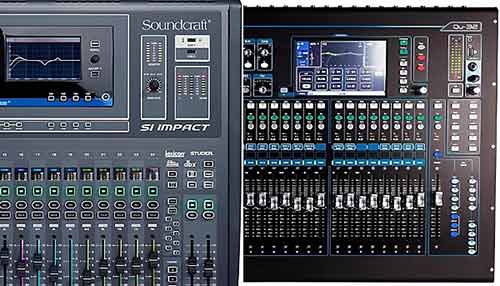 In both live sound reinforcement and broadcast environments, two digital mixing consoles consistently emerge as benchmarks in the mid-tier segment: the Soundcraft SI Impact and the Allen & Heath QU-32. This comparison excludes other brands deliberately—because, based on current market offerings, no other models deliver this combination of features, audio quality, workflow efficiency, and price-performance ratio.
In both live sound reinforcement and broadcast environments, two digital mixing consoles consistently emerge as benchmarks in the mid-tier segment: the Soundcraft SI Impact and the Allen & Heath QU-32. This comparison excludes other brands deliberately—because, based on current market offerings, no other models deliver this combination of features, audio quality, workflow efficiency, and price-performance ratio.
The selection criteria here are pragmatic and operator-focused: native USB audio and DAW control capabilities without the need for additional drivers on macOS, comprehensive onboard processing (including dynamics, EQs, and effects), and preamp transparency and headroom suitable for both FOH and studio-grade applications.
Each console has unique strengths and limitations. The QU-32 offers deep preamp management, including preset libraries tailored to specific microphone models—an advantage for semi-pro users or mobile rigs seeking speed and reliability. Conversely, the SI Impact emphasizes hands-on, per-channel sound shaping with a signal path more reminiscent of analog workflow logic—something advanced users and engineers will appreciate when critical control over gain staging and routing is required.
Audio fidelity is strong on both desks. However, the SI Impact offers a slightly more open architecture and more customizable routing flexibility, which can be decisive in hybrid setups that alternate between live gigs and studio preproduction.
From a hardware perspective, Soundcraft’s UIX layer structure provides faster access to mix busses and FX sends, while the QU series benefits from Allen & Heath’s solid physical build and touchscreen interface. That said, only trained ears and experienced hands are likely to notice any meaningful difference in output clarity, especially in live environments with limited monitoring conditions.
On the used gear market, Allen & Heath units—particularly the QU-16 and QU-32—remain in high demand and command relatively high prices. Meanwhile, the SI Impact is more abundant, often priced more competitively, especially given its capacity to scale via Soundcraft’s Mini Stagebox expansions and full compatibility with MADI and Dante ecosystems.
For use in event production with non-technical operators, the QU-32 is arguably more accessible. Its channel layout, auto-gain, and scene management systems are intuitive, even for those with minimal prior experience. In contrast, the SI Impact is better suited to environments where deeper configuration and routing are needed, such as small-to-medium radio studios or complex live sessions with multiple monitor sends and FOH needs.
In studio applications—particularly for singer-songwriters, solo producers, or demo production—the QU-32 provides an all-in-one solution with minimal external gear required. But if you’re aiming to reduce reliance on external signal processors and want the mix desk to handle gating, compression, and FX routing with surgical precision, the SI Impact is the more efficient workhorse.
Ultimately, this tier of digital consoles bridges the gap between entry-level gear and fully professional desks starting above the $5,000 mark—territory where brands like Yamaha CL/QL, DiGiCo, and Avid dominate. These mid-range desks are ideal for operators managing both production and diffusion needs without the infrastructure of a major studio or tour.
Personally, while I’ve long respected Allen & Heath for their reliability and user experience, the level of control and granularity available on the SI Impact continues to impress me. In our setup, which must serve both live broadcast and preproduction needs, it’s likely that a Soundcraft SI Impact will soon replace our Yamaha MGP24X. While the Yamaha still delivers solid sonic performance, it lacks several critical tools that the SI Impact integrates seamlessly—making the decision less about brand loyalty and more about operational logic.

